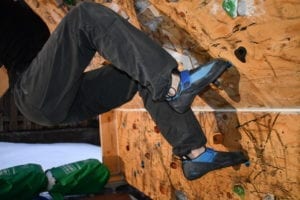Metolius Built Brilliant Metal Footholds
The Metolius Mini Tech foot-chips are a metallic solution to the fragile foothold problem. Never replace, or wash, footholds again

One of the problems with conventional foot chips is how quickly they polish. If your home wall is outside, or you have made your foot holds out of cutoffs, this problem only becomes more pronounced. Water sinks in behind the holds, or the humidity slickens the texture and two burns later you are pulling out deck screws from the place where your foot chip used to be.

Metolius’s solution comes in the form of metal Mini Tech foot chips. This multi-coloured ensemble is equipped for martini-head bolts or screw-on applications and represents an innovative solution to climbing footholds.
To begin, the product hits its mark. This is an important consideration because at $40 per set these are not an inexpensive solution to the climbing hold problem. Though a person might scoff at such a high price for foot-chips, there is one thing to keep in mind. Once you purchase them, they will not need to be replaced.
At first, this might seem like a small victory: polyurethane footholds aren’t exactly delicate. Though it is true that urethane footholds are robust and will last a long time, their texture is impermanent. To that effect, urethane footholds that are fixed to a home wall are unlikely to be cleaned. Though a climber may move their holds around their wall, very few will take out their power washer because very few climbers actually own a power washer.

There are of course chemical-based solutions to cleaning footholds, but these are not easy to apply, nor do they retain the texture of the hold. The Metolius Mini Tech metal chips do not require cleaning. They are metal. The texture is as good on its 100th day as its first day because it is built out of metal layers. Your rubber is not going to wear down this unwearable material.
Naturally, such a dependable product is a bit more challenging to build than pouring polyurethane which, in turn, increases the cost. The climber is not exactly stoked on spending lots of money at any point, so, if these chips are going to cost a lot, then they better be good at their job. Fortunately, they are exceptional.
When they arrive, it is easy to feel skeptical. Their metal construction feels slick in hand and it does not inspire confidence. Sure, they are beautiful, but the hyper-flush design of the chips makes it seem like there is not an orientation that could be usable. Add to this the tiny nature of the chips and it becomes all the more difficult to believe that these could be the solution to your foothold problem.

Screw them onto the wall, however, and they perform immediately. The holds are designed with climbing shoe rubber in mind, and, as the climber puts pressure though their rubber into the holds, the rubber sinks into the corners made by CNC-like layering affect of the foot-holds’ construction. They are stickier than their urethane peers by at least two times, and, that margin increases as the grips become more used. A foothold of the same size, in urethane, in an overhang, is unusable. These, however, even at 50-degrees overhanging, are sticky and responsive.
As a training product, they are optimal. The reason for this is a function of their stickiness and their size. Because they are so small, it takes a lot of control to be able to access each foothold. The climber must move well on the wall if they want to get the good spot on each of these chips. This effort is rewarded with a stable platform from which to move, and, while the foot-chips do require precision, they will not let your feet pop arbitrarily.
This can be difficult to interpret from the climbing perspective because it feels like all footholds are like this. Small foot-chips require precision no matter what they are made of and any well-placed foot will be usable on the smallest hold. While this is true, it can be easy to forget the purpose of using small footholds while board climbing.

They are meant to train precision and core stability. It is easier to train these things when the foothold rewards its use. Think about your home wall. No matter what sorts of holds you use for your feet, you probably have a proclivity for using the foot holds that actually work. Maybe you are primarily tracing, using handholds for foot holds. While this is a great way to train, it allows the climber to rest on the large in-cut grips that are primarily reserved for hands.
Surely there are a few footholds that you use as well, but as the angle gets steeper, the more difficult it becomes to stay on the feet. All of a sudden, your small urethane footholds are simply tools to get your butt off the ground before dead-pointing to another grip. Then you replace your foot on one of the starting handholds, never to touch another foot-chip for the length of the problem. At no-point did you actually train tension. This is what the Mini-tech foothold accomplishes.
Through maximal friction, the climber learns how to climb away from their feet. They engage their lumbar and place their feet in the correct place on the first attempt. This is especially important if you are granite climber for the footholds in your crag are generally sticky if not also low profile. The Metolius foot-chips replicate this sensation.
The question of whether or not you should pick up a set is largely dependent upon the climber’s relationship with their home wall. If you are perpetually using your wall and expect to replace your gym membership with it, they are definitely worth the money. Check them out here.



